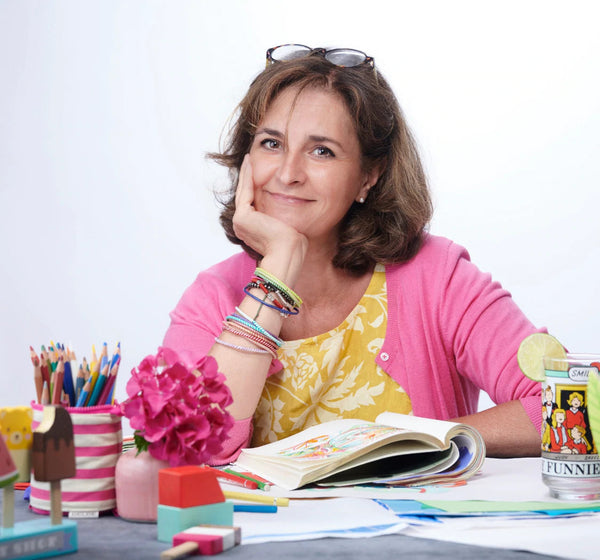Meet the maker: Danielle Hanson

Danielle Hanson is the creative force behind ThreadBear Design. Here we talk about how she started designing toys, her childhood favourites and where she gets her inspiration.
What did you do before Tender Leaf and ThreadBear? What motivated the change?
I started my career in the BBC graphic design department working on moving image. I then trained as an art teacher while bringing up 3 children!. Taught A level graphic design and moving image for 12 years. Ran an after school art club for 10 years…interesting to note that when you give children proper art materials the results are astonishing. Schools need to ban poster paint and bristle brushes.
Before taking the leap to start ThreadBear I was Creative Director for a wooden toy company for 12 years. I left because I wanted the freedom to design a children’s lifestyle brand where my designs could be applied across textiles as well as wooden products. I had the good fortune to not only meet Nick Shirley who had years of experience working in the textile industry, but I also partnered with one of the biggest wooden toy manufacturers in the gift industry and we created Tender Leaf toys.
How has your career as a teacher informed your design work?
I saw in my own children how they different they all can be, how they grow and learn in different stages and so realised the most important part in raising children is to pique their curiosity, show them beauty in the natural world as well as in the arts, understand how they learn and what motivates them, and encourage them to discover what their strengths are.

What is your favourite piece of work with Tender Leaf? And with ThreadBear?
I am most proud of the open ended play toys that I have designed for Tender Leaf - Forest Floor and the Forest Trail Kit. These products were inspired by my love of woodlands and nature. They encourage independent and imaginative play, allow the child to explore, and appeal to any age or gender.

For ThreadBear I love our Waldorf-inspired Liselie doll as she was a challenge to perfect . She is very detailed, has a preformed face and double layer of jersey making her unique in the soft doll market. She is also named after my Swiss grandmother who instilled in me a passion for textiles!

What are your greatest creative inspirations?
My Swiss grandparents were carpenters and my Spanish family were tailors so I already have a love for all things craft and get a lot of inspiration from artisan exhibitions and 20th century design. I especially love children’s literature and illustration and have a large collection of children’s books, both new and vintage. Research into the educational philosophies of Maria Montessori and Reggio Emilia also helped me in my design process.

What was your favourite toy as a child?
It has to be my Pippa doll (I love a bit of vintage plastic!).

Which toys or designs do you find most memorable or interesting?
I love Russian dolls, Dutch dolls, and a German brand named KELLNER, where felt and wood are mixed together to create the most wonderful characters.

I did not train as a product designer and so take a very personal approach when designing children’s products. I want them to look beautiful, with contemporary colours and to appeal to all ages. I want children to discover quirky details that make my designs different.
What do you most enjoy about your work?
I love the design process, illustrating and time spent researching. To perfect each toy, it takes a couple of rounds of design and sample-making.
What are you currently most excited about?
Currently very excited about producing more open ended play toys that encourage creative thinking.
What have been the biggest challenges with your design work?
The biggest challenge is keeping the designs simple. Simple design is usually cheaper to produce - which is better for parents! - but complexity creeps in. Paring it down is difficult but necessary work.
What do you hope to achieve with your designs?
I would like our toys to be kept for future generations instead of added to landfill when the child has outgrown them.





